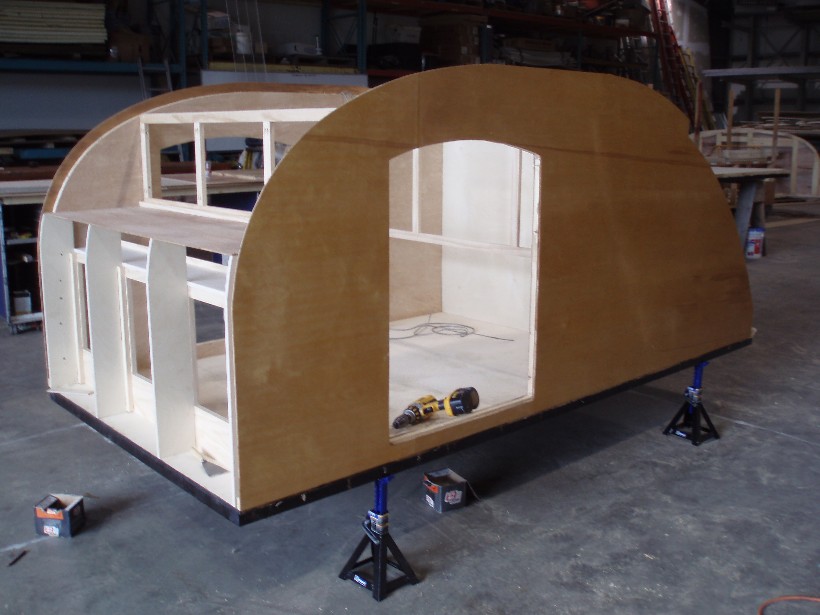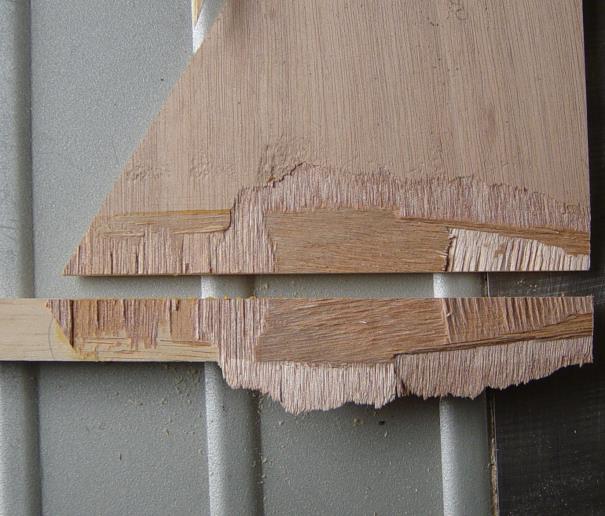Page 1 of 1
Gluing framing to the exterior wall?

Posted:
Fri May 08, 2009 3:57 pmby bhoogeboom
I am starting the framing for my walls. Is tightbond III enough to hold the framing pieces to the 1/4 " plywood? Or, do I need to screw the frame to the wall as well?

Posted:
Fri May 08, 2009 4:28 pmby planovet
That's what I did. I did use some screws to hold the frame tight to the exterior skin until the glue dried and then backed them out. Since the frame was sandwiched the screw holes will not show. I just glued the interior skins and held them in place with clamps and weights.

Posted:
Fri May 08, 2009 4:40 pmby Walt M
the only glue I use is PL polyurethane,imo it's by far the best adhesive I've ever used. It's tough to use, just because once you get it on your hands it takes a week to get off. Walt

Posted:
Fri May 08, 2009 8:47 pmby kennyrayandersen
Glue and screw to be sure, but I’m too lazy to take them back out – slap some putty, hit it with a sander and go. To be sure the glue takes the load, but the screws shouldn’t hurt anything if you leave them in.

Posted:
Fri May 08, 2009 8:49 pmby mikeschn
I always leave my screws in, recess them a bit, and fill the recess with fiberglass putty.
I have a dresser that I built 10 years ago, and all the glue joints have broken. I'd hate to have something like that happen on the highway...
Mike...

Posted:
Fri May 08, 2009 8:56 pmby Walt M
Depending what you want for a look, if you put some weight on the skin as you apply it to the frame. You don't have to use nails or screws or putty the holes and now you get natural wood look.

Walt

Posted:
Sat May 09, 2009 9:02 amby bbarry
I used epoxy to bond my interior and exterior skins to the framing. No mechanical fasteners. I'm definitely not worried about it falling apart going down the road.
Brad

Posted:
Sat May 09, 2009 11:11 amby schaney
A good glue joint will always be stronger than the surrounding wood. So assuming proper design, no fastners are necessary. That said, in many cases, I find it quicker to use screws verses clamps for gluing, when I do, I normally leave them in and fill over them.

When using Titebond II/III you need a tight joint to get proper gluing. In the above picture you'll notice the area of poor bonding in the lower left. The piece had clamps every 1".
When your joints are a bit loose, as in bonding an outer skin on with weights like Walt M described, I always use thickened epoxy to ensure a good joint because of it's gap filling properties.

Posted:
Sat May 09, 2009 11:41 amby Walt M
you guys who use epoxy for bonding. Does it cure quick so you can continue right away? Walt

Posted:
Sat May 09, 2009 3:20 pmby Esteban
I used Titebond II and 7/8" long narrow crown staples to fasten the 1/4" outside plywood skin to the inner sandwich wall frame. Used dozens of clamps on the edges. Left the assembly alone for a few hours for the glue to set up. Later I fiberglassed (epoxy and cloth) the outside skin.
For fastening the inside birch plywood to the frame I used thickened epoxy. The wall assembly was flat on a bench. I used weights to hold down the birch ply where I didn't want fasteners to show. Where the birch ply will later be covered with inside door trim or by cabinets I used narrow crown staples. Around edges I used lots of clamps too. Again I let it sit undisturbed for a day to set up.
Walt, epoxy takes hours to cure. How long depends on the temperature and the speed of the hardener. Some are fast. Some are slow. So it's best to leave an assembly undisturbed for a day or so. There are some hardeners that set up within minutes. I haven't used them. No real need and too scary for me. Where I wanted to fasten things together quickly, like building the sandwich wall frame, I used Titebond glue with pocket screws and/or biscuits. Or narrow crown staples and glue to fasten plywood as above.

Posted:
Mon May 11, 2009 10:43 pmby wannabefree
The glue you use depends, in part, on where you live. We used TB3 with excellent results. That said, we glued the sides about last Nov here in AZ and had to keep wetting it to keep it from skinning over. If the glue skins before you can put the pieces together you will not get good penetration and the joint is prone to fail.
Epoxy will give you longer open time, but you still have to spread it quickly or it will gel in the mixing pot. As far as water resistance, TB3 is not quite as good, but 1/4 the cost, so my first choice.
A third choice would be a (non-epoxy) resin. I haven't used that stuff in many years, but it has good gap filling properties, is pretty waterproof and has good open time. You can find it in a well-stocked real hardware store. Expect "Huh?" from the local HD or Lowes clerk. It comes in cans, a power that you add to a liquid. IMO, TB3 is just as good and easier to find. It's really too expensive to use in quantity.
Your last choice is PL poly, the stuff in the tube. I had good sucess with that for attaching the roof skin because I needed long open time and good gap filling. I wouldn't use it on the sides because it is "too" good at filling gaps and it might be hard to get the side flat, but it is still an option...

Posted:
Tue May 12, 2009 6:51 amby john
Pl poly stuff??


I have used it on two builds now. The bond is stronger than the wood it bonds. (at least in a few of my accidental tests)
I have found it also works well as a filler and I have in some instances used it as a fillet. Usually in cabinets.
It takes forever to get the stuff off my fingers at the end of the day.

Posted:
Tue May 12, 2009 2:51 pmby Walt M
John, regarding the fact that it really stays on the flesh. Last week I was working on my current build and my brother was helping. He asked if the PL poly was good glue, I said you'll know how good when you try to wash it off. Walt

